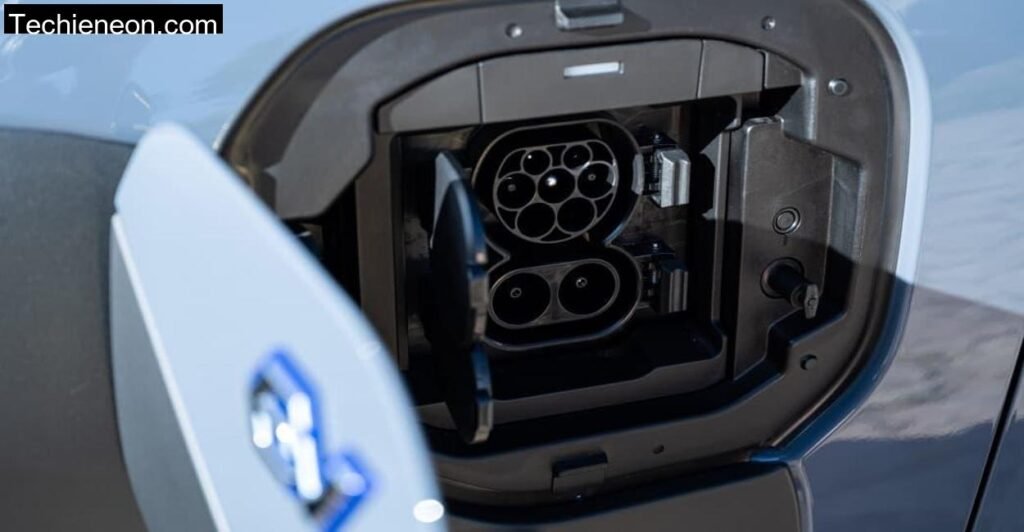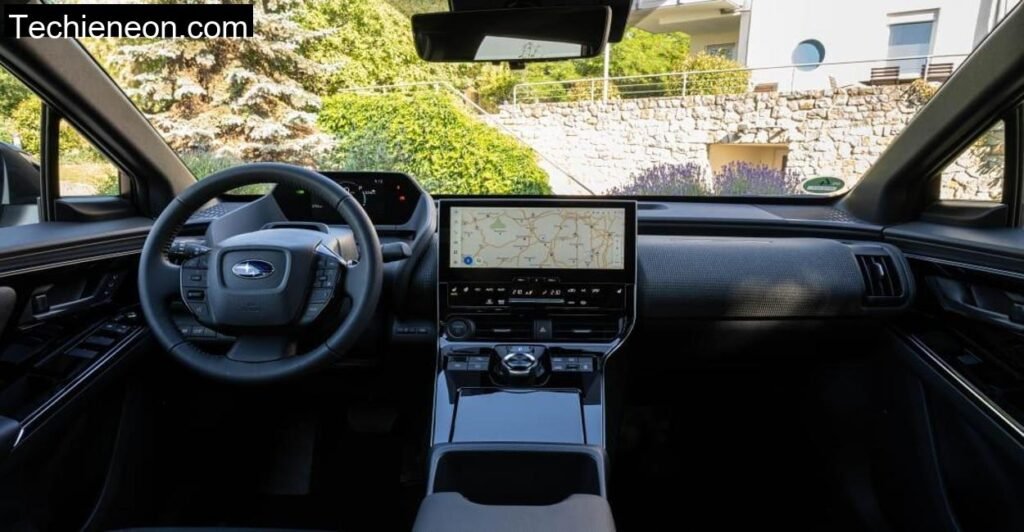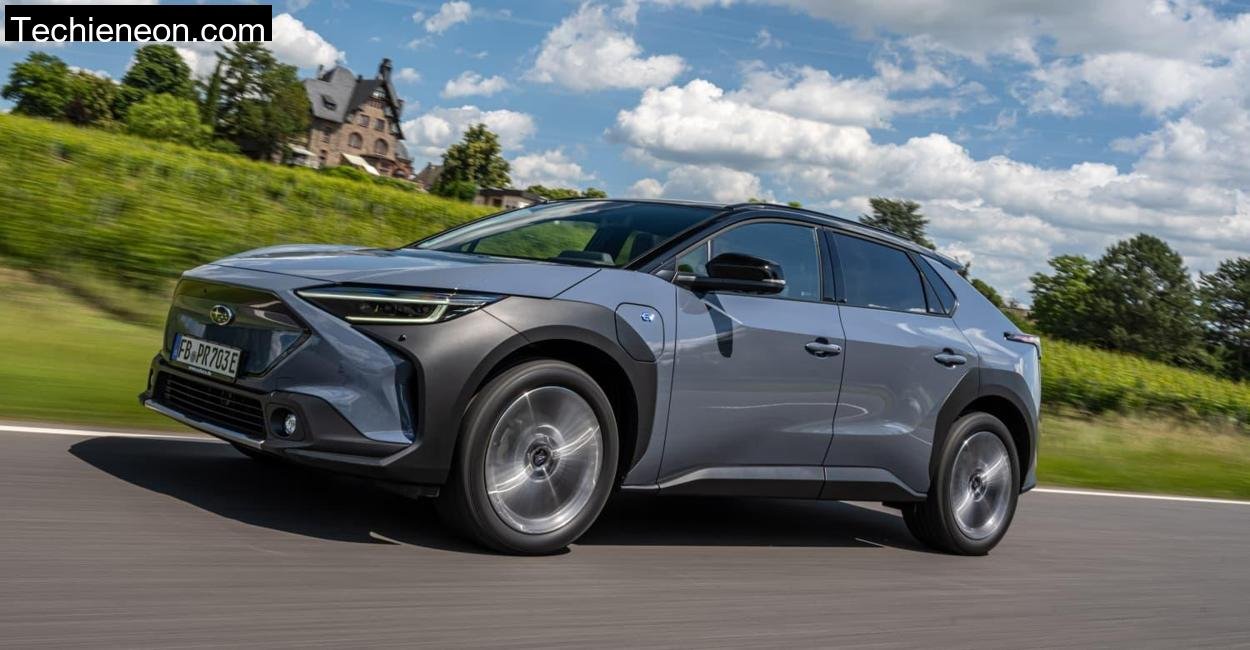It was late October when I headed to the highest point in Brandenburg, the Heidehöhe, a modest 201 meters above sea level but a surprisingly scenic area, surrounded by pine forests and winding backroads perfect for putting a new electric SUV through its paces. The car in question? Subaru’s first-ever all-electric model: the Solterra. It’s got AWD in its blood and Toyota in its DNA, but does it live up to the brand’s reputation for ruggedness and reliability?
I was curious, skeptical, and, frankly, excited. I’ve known Subaru for its boxer engines and symmetrical all-wheel drive. But here I was, stepping into something entirely new: a quiet hum replacing the signature engine growl, a minimalist interior replacing hard-wearing dashboards. Time to find out if the Solterra is more than just a badge-swapped bZ4X.
Subaru Solterra and Toyota bZ4X Identical
Let’s get this out of the way: the Subaru Solterra is basically a Toyota bZ4X with some tweaks. Co-developed by both brands, the two EVs share nearly everything underneath the skin, platform, motors, battery, and much of the interior. But the Solterra is AWD-only, while the Toyota offers a front-wheel-drive variant as well.
The dual motors, one front, one rear, each deliver 80 kW (109 hp), for a combined output of 160 kW (218 hp). On paper, that’s a good figure. On tarmac, it translates into brisk acceleration without the neck-snapping punch you get in some other EVs. Still, for everyday driving on winding Heidehöhe lanes, it’s more than sufficient.
Despite its Toyota roots, the Solterra has a Subaru-specific tuning for traction and off-road capability. On a gravel trail cutting through the forest, X-Mode (Subaru’s off-road setting) kept the car steady and composed. You’d think the Solterra was born for soft roading, because it kind of was.
The Range of the Solterra

Subaru claims up to 466 kilometers of range according to the WLTP cycle. That’s in the base “Comfort” trim. The “Platinum Plus” model I tested, thanks to its larger wheels and extra weight, officially drops to around 416 km.
But let’s talk real world. Independent Ecotest came up with 350 km, and that tracks well with my experience. On the rolling hills of the Heidehöhe and the nearby Langenlipsdorf countryside, I drove conservatively, using regenerative braking where I could. The result? A projected 345 km from full to empty.
That’s not bad for a 71.4 kWh battery pack, especially when you factor in the 20.0 kWh/100 km average consumption (including charging losses). Efficient? Reasonably. Exceptional? No. Acceptable? Definitely.
The Solterra Has a Problem in Cold Weather
Now let’s get to the painful part: winter. On a cold morning in Brandenburg (around 3°C), I reset the trip meter and hit the road. Highway driving at 120 km/h drained the battery fast. The onboard readout spiked up to 29.5 kWh/100 km, confirming the Solterra’s Achilles heel: poor winter efficiency.
And it doesn’t stop there. Cold temps also put the brakes on charging speed. Subaru promises 150 kW peak DC charging, but I only saw that number for about three minutes before it dropped off sharply. Over a 10 to 80 percent session, it averaged 93.7 kW, which meant a 30-minute pit stop got me to 77 percent.
Worse still: the AC onboard charger maxes out at 7.4 kW. So if you’re plugging in overnight with a wall box, you’re looking at around 9.5 hours from empty to full.
And no, the navigation system won’t help you plan charging stops. For a €50K car in 2024, that’s borderline unacceptable.
The Subaru Solterra Has Very Comfortable Suspension
This is where things start looking up again. Comfort is where the Solterra shines. Rolling over the worn-out cobbled roads near Schönewalde, the car soaked up every bump without flinching. No adaptive dampers here, just really good tuning.
Even with the standard 20-inch wheels, the ride was buttery smooth. Urban speed bumps? Barely felt. Country potholes? Glided over. On the open stretches of Bundesstraße 101, the Solterra floated quietly and steadily, with no fidgetiness or bounce.
And that’s no small feat. Many EVs try too hard to feel “sporty” and end up with harsh suspension. Subaru went the other way and nailed it.
Large Trunk and Plenty of Space in the Front

Space matters, especially if you’re trading in a Forester or Outback. The Solterra delivers in spades. Up front, the seating position is SUV-tall, and even at 1.90 meters, I had tons of headroom, though the panoramic roof does nibble into it slightly.
Getting in and out is easy, thanks to wide doors and high seating, though the door sills are a tad too elevated. In back, legroom is fantastic, but headroom for rear passengers over 1.85 meters gets tight due to the sloping roof.
The trunk? Measured at 480 liters, it swallowed my travel duffel, a hiking pack, and three crates of mineral water without complaint. Fold the rear seats and you get 1,415 liters, roomy even by mid-size SUV standards.
Operation Requires Some Getting Used To
The dashboard looks modern, clean, but takes some acclimatization. The instrument cluster sits high, above the steering wheel in Peugeot-style fashion. You’ll need to lower the wheel far down into your lap to see the display fully,awkward for some body types.
The infotainment system has a 12.3-inch screen, but its menus are… let’s call them “deep.” You will get lost at least once. At least climate control has its own panel, kudos for that, but the touch-sensitive buttons are slow to react and lack tactile feedback.
Another letdown: the battery state-of-charge isn’t shown in percent. Just a vague bar. For an EV, that’s just not good enough anymore.
Good Driving Performance, Top in the Evasion Test
Don’t let the 218 hp fool you, this SUV has surprising pep. On a deserted forest road, I nailed the throttle from a standstill: 0–100 km/h in 6.9 seconds feels faster than it sounds. There’s an immediacy to electric torque that makes overtaking effortless.
Mid-range is excellent: 60–100 km/h in just four seconds. Highway merging is stress-free, and it pulls steadily until the 160 km/h limiter kicks in.
What impressed me most was how the Solterra performed in the evasive maneuver test. Despite its hefty 2-ton curb weight, it handled quick direction changes with surprising poise. Traction was flawless, thank the symmetrical AWD for that.
Assistance Systems: Safety Is Ensured
Subaru didn’t skimp on safety in the Solterra, equipping it with a full suite of modern driver assistance systems. Emergency braking comes with pedestrian detection and works reliably in urban settings, with smooth intervention rather than jarring stops. Adaptive cruise control handles highway driving with confident distance management and gentle braking, maintaining a natural flow even when traffic patterns become erratic. Lane keeping assist functions subtly, not overly aggressive in nudging the wheel, but active enough to prevent drift on longer stretches of road.
Blind spot monitoring and rear cross traffic alert are ever-watchful companions in tight parking lots or while merging onto a busy Bundesstraße, offering clear visual alerts through the mirrors and dashboard cluster. Driver attention warning uses steering and lane data to detect fatigue or distraction, issuing an audible alert if it senses your focus wavering.
All these systems fall under the umbrella of Subaru Safety Sense, which integrates them into a cohesive package. It doesn’t just throw individual features at the driver, it actually feels like a unified safety net.
There is, however, one quirk that stood out during my drive. The traffic sign recognition system draws from two sources: an onboard camera that reads signs in real time and a navigation-based database. When these two inputs disagree, confusion sets in. At one point near Langenlipsdorf, the digital speed limit on the main screen said 70 km/h while the cluster insisted it was 50. Not ideal, especially when you’re relying on the system for guidance in unfamiliar territory.
Still, apart from this inconsistency, the driver assistance tech in the Solterra is confident, polished, and well-integrated. Subaru didn’t just tick boxes, they built a safety system that feels genuinely supportive without being intrusive.
Conclusion
The Subaru Solterra is a solid debut into the EV world, but it’s not perfect. It carries Subaru’s signature strengths: all-wheel drive competence, ruggedness, comfort, and safety. Where it stumbles is in its winter behavior and some of the EV-specific tech. Charging speeds drop sharply, range tanks in the cold, and the infotainment feels dated in spots.
But as a daily driver? A family hauler? A weekend trail explorer? It fits the bill. The ride comfort alone sets it apart from many rivals. For the right buyer, especially a loyal Subaru one, it makes a compelling, if cautious, step into the electric future.


Leave a Comment